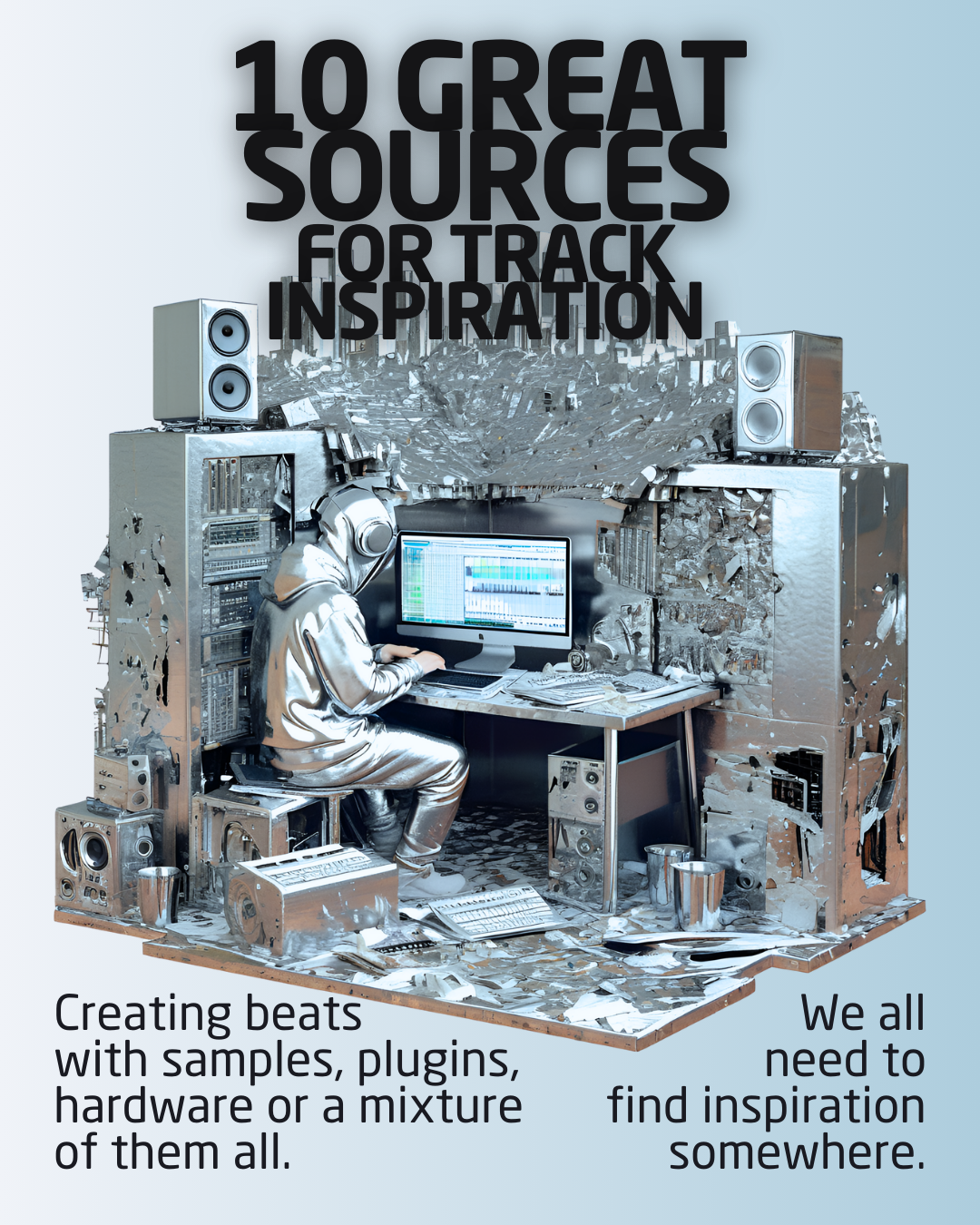
10 great sources for track inspiration
Finding inspiration for electronic music production can sometimes be a challenge, but there are countless sources to help ignite creativity. Here are some places and methods to help you stay inspired
1. Listen to Music
Explore New Genres: Discovering new genres or subgenres (e.g., ambient, glitch, IDM, minimal techno, future bass) can give you fresh ideas on how to approach rhythm, harmony, and sound design.
Deep Dive into Artists: Listen to artists who push the boundaries of electronic music. Explore not just their popular tracks, but also their deeper cuts and live performances.
Remixes and Covers: Look for remixes of popular tracks or listen to covers of electronic music in different styles or genres to get a fresh perspective.
2. Sound Design Exploration
Experiment with Synths and Effects: Start by randomly creating sounds on a synthesizer or experimenting with sound effects. Sometimes, the best ideas come from simply playing around and finding new textures or tones.
Presets as a Starting Point: You don’t have to create everything from scratch. Load up a preset in a synth or sampler, and then manipulate it (changing filters, adding effects) to make it your own.
Sample Packs and Field Recordings: Samples like our Dimensions range can be a great way to spark inspiration with hundreds of evocative sounds they can be an excellent way to kickstart your creativity.

3. Music Production Challenges
Remake a Song: Try recreating a track you like. It’ll give you a deeper understanding of how certain elements (like drums, basslines, or synths) fit together and may inspire your own creations.
Random Sound Generation: Use tools or plugins that generate sounds randomly, then try to incorporate them into a composition. This can push you out of your comfort zone.
Creative Limitations: Restrict yourself to using only certain instruments or sounds for a track. For example, using only one synth or limiting yourself to only percussive elements.

4. Collaborate with Others
Collaboration: Work with other producers, vocalists, or musicians. Collaboration often brings new ideas and can push you to explore different approaches to music-making.
Remix Contests: Participate in remix contests. The stems or original tracks will give you a solid foundation, and the competition can spark creativity.

5. Inspiration from Visual Arts
Movies and TV Shows: Soundtracks, especially in sci-fi or horror genres, are packed with unique sound design that can inspire atmospheric textures, ambiances, or motifs for your tracks.
Art and Photography: Look at abstract art, landscapes, or even photographs. You can translate visual elements (color schemes, moods, lighting) into sound.
Video Games: The soundtracks in video games often offer creative and unique compositions. The variety of sounds—from orchestral to electronic—can inspire fresh ideas.'

6. Nature and the Environment
Field Recordings: Go out with a recorder or smartphone to capture sounds from nature or urban environment and field recordings from places like forests, beaches, or city streets can be used to create textures or interesting soundscapes.
Everyday Sounds: Sometimes ordinary, everyday sounds (e.g., the hum of an air conditioner, clinking of cups, or footsteps) can be transformed into musical elements through processing and layering.

7. Social Media and Online Communities
Reddit: Subreddits like r/WeAreTheMusicMakers, r/edmproduction, and r/synthesizers often have threads that feature challenges, production tips, or discussions that can trigger fresh ideas.
YouTube Tutorials and Channels: There are countless channels dedicated to electronic music production (e.g., ADSR, Point Blank Music School, Simply Sonic). Watching other producers' workflows can inspire new techniques and sounds.
SoundCloud and Bandcamp: Browse through SoundCloud or Bandcamp for lesser-known artists, especially those experimenting with unique or avant-garde sounds. This can give you a fresh approach to structure or style.

8. Your Own Emotions and Experiences
Write From Your Own Feelings: Use your current emotional state as inspiration. A track that expresses a certain mood, feeling, or story can be more engaging than focusing purely on technical elements.
Personal Life Experiences: Create a track based on a specific memory or event in your life, and translate that into sound through instrumentation, melodies, and textures.

9. Live Performance
Live DJ Sets: Watching or listening to live DJ sets (especially in genres like techno, house, or trance) can give you ideas for transitions, energy flow, and mixing.
Improvisation: Try recording a live jam session on your gear, without overthinking it. Spontaneous improvisation often leads to unexpected and interesting results.
10. Experimental Methods
Random Generators: Tools like RANDOM in Ableton or a MIDI randomizer can generate musical ideas you wouldn’t think of otherwise.
Collage Method: Take snippets of other genres or tracks and rearrange them to form something new. This can lead to unique fusions of style.
Noise Music: Play around with noise elements and create soundscapes that explore more abstract or experimental techniques.

Bonus Tip: Stay Consistent
Sometimes, the best inspiration comes from simply sitting down and working regularly. Even if you're not feeling particularly inspired, consistent practice can lead to breakthroughs. Consider setting small goals (like finishing a 1-minute track) or focusing on one element of production (like creating just the drums or bassline).
By drawing from multiple sources—whether it’s other music, nature, visual arts, or your own emotions—you can spark a continuous flow of creative energy. Keep experimenting and exploring new ways to approach music creation!



